Data Typologies in Urban Housing Research: A Systematic Review of the Literature
Abstract
1. Introduction
- To identify the dominant research themes in housing studies that engage with data;
- To classify the types of data sources used in these studies and the methods applied to analyse them;
- To explore how data availability shapes research focus, particularly in underexamined themes, to inform directions for future research.
2. Materials and Methods
2.1. Search Strategy
2.2. Study Selection
- Inclusion criteria: studies addressing housing supply and/or demand and applying one or more identifiable data sources.
- Exclusion criteria: studies outside the scope of this research (e.g., unrelated disciplines), those lacking clarity on data sources, or those not aligned with the study objectives.
2.3. Review Approach
3. Results
3.1. Housing Research Typology
3.1.1. Housing Market Analysis
3.1.2. Rental Market Analysis
3.1.3. Housing Policy Evaluation
3.1.4. Housing Affordability
3.1.5. Housing Inequality
3.2. Data Source Typology
3.2.1. Official Statistics
3.2.2. Non-Official Statistics
3.2.3. Survey and Qualitative Data
3.2.4. Big Data
3.2.5. Social Media
3.3. Anaytic Methods Used in Housing Research
3.4. Formal and Informal Housing Typology
3.4.1. Formal Housing
3.4.2. Informal Housing
3.4.3. Formal–Informal Housing
4. Discussion: A Cross-Examination of Housing Theme, Data Sources, and Analytic Methods
4.1. Application of Data Sources in Housing Research
4.2. Analytic Methods and Data Source Types
4.3. Use of Data Source Across Housing Types
4.4. Big Data for Forecasting in Housing Strategic Planning
5. Conclusions
5.1. Importance of Data Sources in Housing Research
5.2. Research Gaps in Informal Housing and Underutilisation of Emerging Data Sources
5.3. Limitations of the Study and Future Research Directions
Supplementary Materials
Author Contributions
Funding
Institutional Review Board Statement
Informed Consent Statement
Data Availability Statement
Conflicts of Interest
References
- Nasreen, Z.; Ruming, K. Struggles and opportunities at the platform interface: Tenants’ experiences of navigating shared room housing using digital platforms in Sydney. J. Hous. Built Environ. 2021, 37, 1537–1554. [Google Scholar] [CrossRef]
- Rae, A. Online Housing Search and the Geography of Submarkets. Hous. Stud. 2015, 30, 453–472. [Google Scholar] [CrossRef]
- Sawyer, S.; Crowston, K.; Wigand, R.T. Digital assemblages: Evidence and theorising from the computerisation of the US residential real estate industry. New Technol. Work. Employ. 2014, 29, 40–56. [Google Scholar] [CrossRef]
- Fields, D.; Rogers, D. Towards a Critical Housing Studies Research Agenda on Platform Real Estate. Hous. Theory Soc. 2021, 38, 72–94. [Google Scholar] [CrossRef]
- Boeing, G.; Waddell, P. New Insights into Rental Housing Markets across the United States: Web Scraping and Analyzing Craigslist Rental Listings. J. Plan. Educ. Res. 2016, 37, 457–476. [Google Scholar] [CrossRef]
- Lifang, Z.; Ting, Y.; Yang, L.; Li, Z. Analyses on the Spatial Distribution Characteristics of Urban Rental Housing Supply and Demand Hotspots Based on Social Media Data. In Proceedings of the 2020 5th IEEE International Conference on Big Data Analytics (ICBDA), Xiamen, China, 8–11 May 2020; pp. 126–130. [Google Scholar]
- Maalsen, S.; Shrestha, P.; Gurran, N. Informal housing practices in the global north: Digital technologies, methods, and ethics. Int. J. Hous. Policy 2022, 22, 1–9. [Google Scholar] [CrossRef]
- Gurran, N.; Pill, M.; Maalsen, S. Hidden homes? Uncovering Sydney’s informal housing market. Urban Stud. 2021, 58, 1712–1731. [Google Scholar] [CrossRef]
- Shrestha, P.; Gurran, N.; Maalsen, S. Informal housing practices. Int. J. Hous. Policy 2021, 21, 157–168. [Google Scholar] [CrossRef]
- Nasreen, Z.; Ruming, K.J. Informality, the marginalised and regulatory inadequacies: A case study of tenants’ experiences of shared room housing in Sydney, Australia. Int. J. Hous. Policy 2021, 21, 220–246. [Google Scholar] [CrossRef]
- Ferreri, M.; Sanyal, R. Digital informalisation: Rental housing, platforms, and the management of risk. Hous. Stud. 2021, 37, 1035–1053. [Google Scholar] [CrossRef]
- Alkan, Ö.; Karaaslan, A.; Abar, H.; ÇElİK, A.K.; Oktay, E. Factors affecting motives for housing demand the case of a Turkish province. Theor. Empir. Res. Urban Manag. 2014, 9, 70–86. [Google Scholar] [CrossRef][Green Version]
- Opoku, R.A.; Abdul-Muhmin, A.G. Housing preferences and attribute importance among low-income consumers in Saudi Arabia. Habitat Int. 2010, 34, 219–227. [Google Scholar] [CrossRef]
- Trubka, R.; Glackin, S. Modelling housing typologies for urban redevelopment scenario planning. Comput. Environ. Urban Syst. 2016, 57, 199–211. [Google Scholar] [CrossRef]
- Goodchild, B.; Ferrari, E. Intermediaries and mediators: An actor-network understanding of online property platforms. Hous. Stud. 2021, 39, 102–123. [Google Scholar] [CrossRef]
- Pettit, C.; Crommelin, L.; Sharam, A.; Hulse, K. The Potential of New Technologies to Disrupt Housing Policy; Australian Housing and Urban Research Institute Limited: Melbourne, Australia, 2018. [Google Scholar]
- Shaw, J. Platform Real Estate: Theory and practice of new urban real estate markets. Urban Geogr. 2020, 41, 1037–1064. [Google Scholar] [CrossRef]
- Serin, B. Reviewing the Housing Supply Literature. Available online: https://housingevidence.ac.uk/publications/reviewing-the-housing-supply-literature/ (accessed on 14 April 2025).
- Naik, M. Informal Rental Housing Typologies and Experiences of Low-income Migrant Renters in Gurgaon, India. Environ. Urban. ASIA 2015, 6, 154–175. [Google Scholar] [CrossRef]
- Maalsen, S. I cannot afford to live alone in this city and I enjoy the company of others: Why people are share housing in Sydney. Aust. Geogr. 2019, 50, 315–332. [Google Scholar] [CrossRef]
- Khaire, M.; Muniappa, N. Housing policy research in India: A scoping review and thematic analysis. Int. J. Hous. Mark. Anal. 2022, 15, 339–356. [Google Scholar] [CrossRef]
- Page, M.J.; Moher, D.; Bossuyt, P.M.; Boutron, I.; Hoffmann, T.C.; Mulrow, C.D.; Shamseer, L.; Tetzlaff, J.M.; Akl, E.A.; Brennan, S.E.; et al. PRISMA 2020 explanation and elaboration: Updated guidance and exemplars for reporting systematic reviews. BMJ 2021, 372, n160. [Google Scholar] [CrossRef]
- Shosha, B.; Anamali, A.; Zisi, A. Anomalies of the housing market in Albania. Univers. J. Account. Financ. 2021, 9, 275–284. [Google Scholar] [CrossRef]
- Nistor, A.; Reianu, D. Determinants of housing prices: Evidence from Ontario cities, 2001–2011. Int. J. Hous. Mark. Anal. 2018, 11, 541–556. [Google Scholar] [CrossRef]
- Kuang, W.; Liu, P. Inflation and House Prices: Theory and Evidence from 35 Major Cities in China. Int. Real Estate Rev. 2015, 18, 217–240. [Google Scholar] [CrossRef]
- Osei, M.J.; Winters, J.V. Labor Demand Shocks and Housing Prices Across the United States: Does One Size Fit All? Econ. Dev. Q. 2019, 33, 212–219. [Google Scholar] [CrossRef]
- Trofimov, I.D.; Aris, N.M.; Xuan, D.C.D. Macroeconomic and Demographic Determinants of Residential Property Prices in Malaysia. Zagreb Int. Rev. Econ. Bus. 2018, 21, 71–96. [Google Scholar] [CrossRef]
- Wu, C.; Ye, X.; Ren, F.; Wan, Y.; Ning, P.; Du, Q. Spatial and Social Media Data Analytics of Housing Prices in Shenzhen, China. PLoS ONE 2016, 11, e0164553. [Google Scholar] [CrossRef]
- Mei, Y.; Hite, D.; Sohngen, B. Demand for urban tree cover: A two-stage hedonic price analysis in California. For. Policy Econ. 2017, 83, 29–35. [Google Scholar] [CrossRef]
- Gao, X.; Asami, Y. Preferential size of housing in Beijing. Habitat Int. 2011, 35, 206–213. [Google Scholar] [CrossRef]
- Ahsan, M.M.; Sadak, C. Exploring housing market and urban densification during COVID-19 in Turkey. J. Urban Manag. 2021, 10, 218–229. [Google Scholar] [CrossRef]
- Chu, J.; Duan, Y.; Yang, X.; Wang, L. The Last Mile Matters: Impact of Dockless Bike Sharing on Subway Housing Price Premium. Manag. Sci. 2021, 67, 297–316. [Google Scholar] [CrossRef]
- Hilber, C.A.L.; Rouwendal, J.; Vermeulen, W. Local economic conditions and the nature of new housing supply. J. Econ. Geogr. 2020, 21, 339–366. [Google Scholar] [CrossRef]
- Ramli, F.; Zainal, R.; Ali, M. Prediction supply modelling for high-cost housing in Malaysia. Int. J. Supply Chain Manag. 2019, 8, 657–664. [Google Scholar]
- Gulyani, S.; Talukdar, D.; Bassett, E.M. A sharing economy? Unpacking demand and living conditions in the urban housing market in Kenya. World Dev. 2018, 109, 57–72. [Google Scholar] [CrossRef]
- Rosenthal, S.S. Are Private Markets and Filtering a Viable Source of Low-Income Housing? Estimates from a "Repeat Income" Model. Am. Econ. Rev. 2014, 104, 687–706. [Google Scholar] [CrossRef]
- Du, J.; Yang, Y.; Li, D.; Zuo, J. Do investment and improvement demand outweigh basic consumption demand in housing market? Evidence from small cities in Jiangsu, China. Habitat Int. 2017, 66, 24–31. [Google Scholar] [CrossRef]
- Liu, H.; Yi, D.; Zheng, S. Small property rights housing in major Chinese cities: Its role and the uniqueness of dwellers. Habitat Int. 2018, 77, 121–129. [Google Scholar] [CrossRef]
- Lee, C.-C.; Liang, C.-M.; Chen, J.-Z.; Tung, C. Effects of the housing price to income ratio on tenure choice in Taiwan: Forecasting performance of the hierarchical generalized linear model and traditional binary logistic regression model. J. Hous. Built Environ. 2018, 33, 675–694. [Google Scholar] [CrossRef]
- Lee, S.; Shin, K.; Kim, J.-h.; Kim, J.-J. Comparison of Dynamics in the Korean Housing Market Based on the FDW Model for the Periods Before and After the Macroeconomic Fluctuations. J. Asian Arch. Build. Eng. 2014, 13, 117–124. [Google Scholar] [CrossRef]
- Belke, A.; Keil, J. Fundamental Determinants of Real Estate Prices: A Panel Study of German Regions. Int. Adv. Econ. Res. 2018, 24, 25–45. [Google Scholar] [CrossRef]
- Zhou, X.; Qin, Z.; Zhang, Y.; Zhao, L.; Song, Y. Quantitative Estimation and Spatiotemporal Characteristic Analysis of Price Deviation in China’s Housing Market. Sustainability 2019, 11, 7232. [Google Scholar] [CrossRef]
- Agnew, K.; Lyons, R.C. The impact of employment on housing prices: Detailed evidence from FDI in Ireland. Reg. Sci. Urban Econ. 2018, 70, 174–189. [Google Scholar] [CrossRef]
- Cui, N.; Gu, H.; Shen, T.; Feng, C. The Impact of Micro-Level Influencing Factors on Home Value: A Housing Price-Rent Comparison. Sustainability 2018, 10, 4343. [Google Scholar] [CrossRef]
- Lyons, R.C. The real value of house prices: What the cost of accommodation can tell policymakers. J. Stat. Soc. Inq. Soc. Irel. 2011, 41, 71–91. [Google Scholar]
- Ram, Y.; Tchetchik, A. Complementary or competitive? Interrelationships between hotels, Airbnb and housing in Tel Aviv, Israel. Curr. Issues Tour. 2021, 25, 3579–3590. [Google Scholar] [CrossRef]
- Ahmad, S. Housing demand and housing policy in urban Bangladesh. Urban Stud. 2014, 52, 738–755. [Google Scholar] [CrossRef]
- Ofori, P. Housing poverty in developing countries: Challenges and implications for decent accommodation in Swedru, Ghana. Acta Str. 2020, 27, 57–92. [Google Scholar] [CrossRef]
- Carmona, J.; Lampe, M.; Rosés, J. Housing affordability during the urban transition in Spain. Econ. Hist. Rev. 2017, 70, 632–658. [Google Scholar] [CrossRef]
- Zou, Z. Examining the Impact of Short-Term Rentals on Housing Prices in Washington, DC: Implications for Housing Policy and Equity. Hous. Policy Debate 2020, 30, 269–290. [Google Scholar] [CrossRef]
- Camilleri, D. A long-term analysis of housing affordability in Malta. Int. J. Hous. Mark. Anal. 2011, 4, 31–57. [Google Scholar] [CrossRef]
- Önder, K.; Turgut, H. Examination of the Factors Affecting Household Rental Housing Demand Through Data Mining. Eskişeh. Osman. Üniv. İktisadi İdari Bilim. Derg. 2018, 13, 227–238. [Google Scholar] [CrossRef]
- De, U.K.; Vupru, V. Location and neighbourhood conditions for housing choice and its rental value. Int. J. Hous. Mark. Anal. 2020, 10, 519–538. [Google Scholar] [CrossRef]
- Zheng, X.; Xia, Y.; Hui, E.C.M.; Zheng, L. Urban housing demand, permanent income and uncertainty: Microdata analysis of Hong Kong’s rental market. Habitat Int. 2018, 74, 9–17. [Google Scholar] [CrossRef]
- Festus Okoh, A.; Paul Kitson Baffour, A.; Obodai, J. Changing family systems in Ghana and its effects on access to urban rental housing: A study of the Offinso Municipality. J. Hous. Built Environ. 2018, 33, 893–916. [Google Scholar] [CrossRef]
- Li, H.; Wei, Y.D.; Wu, Y.; Tian, G. Analyzing housing prices in Shanghai with open data: Amenity, accessibility and urban structure. Cities 2019, 91, 165–179. [Google Scholar] [CrossRef]
- Famuyiwa, F.; Kayode Babawale, G. Hedonic values of physical infrastructure in house rentals. J. Facil. Manag. 2014, 12, 211–230. [Google Scholar] [CrossRef]
- Femi, A.B.; Khan, T.H.; Ahmad, A.S.B.H.; Udin, A.B. Impact of Tertiary Institutions on House Rental Value in Developing City. Procedia Soc. Behav. Sci. 2015, 172, 323–330. [Google Scholar] [CrossRef]
- Zhou, X.; Tong, W. Learning with self-attention for rental market spatial dynamics in the Atlanta metropolitan area. Earth Sci. Inform. 2021, 14, 837–845. [Google Scholar] [CrossRef]
- Hu, L.; He, S.; Han, Z.; Xiao, H.; Su, S.; Weng, M.; Cai, Z. Monitoring housing rental prices based on social media:An integrated approach of machine-learning algorithms and hedonic modeling to inform equitable housing policies. Land Use Policy 2019, 82, 657–673. [Google Scholar] [CrossRef]
- Ardura Urquiaga, A.; Lorente-Riverola, I.; Ruiz Sanchez, J. Platform-mediated short-term rentals and gentrification in Madrid. Urban Stud. 2020, 57, 3095–3115. [Google Scholar] [CrossRef]
- Sun, W.; Zheng, S.; Wang, R. The capitalization of subway access in home value: A repeat-rentals model with supply constraints in Beijing. Transp. Res. Part A Policy Pr. 2015, 80, 104–115. [Google Scholar] [CrossRef]
- Barron, K.; Kung, E.; Proserpio, D. The Effect of Home-Sharing on House Prices and Rents: Evidence from Airbnb. Mark. Sci. 2021, 40, 23–47. [Google Scholar] [CrossRef]
- Lima, V. Towards an understanding of the regional impact of Airbnb in Ireland. Reg. Stud. Reg. Sci. 2019, 6, 78–91. [Google Scholar] [CrossRef]
- Chen, Y.; Liu, X.; Li, X.; Liu, Y.; Xu, X. Mapping the fine-scale spatial pattern of housing rent in the metropolitan area by using online rental listings and ensemble learning. Appl. Geogr. 2016, 75, 200–212. [Google Scholar] [CrossRef]
- Zhou, X.; Tong, W.; Li, D. Modeling Housing Rent in the Atlanta Metropolitan Area Using Textual Information and Deep Learning. ISPRS Int. J. Geo-Inform. 2019, 8, 349. [Google Scholar] [CrossRef]
- Yang, Y.; Mao, Z. Welcome to My Home! An Empirical Analysis of Airbnb Supply in US Cities. J. Travel Res. 2018, 58, 1274–1287. [Google Scholar] [CrossRef]
- Dudás, G.; Vida, G.; Kovalcsik, T.; Boros, L. A socio-economic analysis of Airbnb in New York City. Reg. Stat. 2017, 7, 135–151. [Google Scholar]
- Harten, J.G.; Kim, A.M.; Brazier, J.C. Real and fake data in Shanghai’s informal rental housing market: Groundtruthing data scraped from the internet. Urban Stud. 2021, 58, 1831–1845. [Google Scholar] [CrossRef]
- Zhang, Y.; Gurran, N. Understanding the Share Housing Sector: A Geography of Group Housing Supply in Metropolitan Sydney. Urban Policy Res. 2021, 39, 16–32. [Google Scholar] [CrossRef]
- LaCour-Little, M.; Wu, W. Density Control, Home Price Appreciation, and Rental Growth in the United States. Cityscape 2021, 23, 75–100. [Google Scholar]
- Anenberg, E.; Kung, E. Can more housing supply solve the affordability crisis? Evidence from a neighborhood choice model. Reg. Sci. Urban Econ. 2020, 80, 103363. [Google Scholar] [CrossRef]
- Kim, A.M. The extreme primacy of location: Beijing’s underground rental housing market. Cities 2016, 52, 148–158. [Google Scholar] [CrossRef]
- Talukdar, D. Cost of being a slum dweller in Nairobi: Living under dismal conditions but still paying a housing rent premium. World Dev. 2018, 109, 42–56. [Google Scholar] [CrossRef]
- Beatty, T.K.M.; Sommervoll, D.E. Discrimination in rental markets: Evidence from Norway. J. Hous. Econ. 2012, 21, 121–130. [Google Scholar] [CrossRef]
- Boeing, G.; Besbris, M.; Schachter, A.; Kuk, J. Housing Search in the Age of Big Data: Smarter Cities or the Same Old Blind Spots? Hous. Policy Debate 2021, 31, 112–126. [Google Scholar] [CrossRef]
- Hess, C.; Acolin, A.; Walter, R.; Kennedy, I.; Chasins, S.; Crowder, K. Searching for housing in the digital age: Neighborhood representation on internet rental housing platforms across space, platform, and metropolitan segregation. Environ. Plan. A Econ. Space 2021, 53, 2012–2032. [Google Scholar] [CrossRef]
- Gurran, N.; Maalsen, S.; Shrestha, P. Is ‘informal’ housing an affordability solution for expensive cities? Evidence from Sydney, Australia. Int. J. Hous. Policy 2020, 22, 10–33. [Google Scholar] [CrossRef]
- Bensús Talavera, V. Densificación (no) planificada de una metrópoli. El caso del Área Metropolitana de Lima 2000–2014. Rev. INVI 2018, 33, 9–51. [Google Scholar] [CrossRef]
- Gurran, N.; Phibbs, P. When Tourists Move In: How Should Urban Planners Respond to Airbnb? J. Am. Plan. Assoc. 2017, 83, 80–92. [Google Scholar] [CrossRef]
- Cheshire, P.; Hilber, C.A.L.; Koster, H.R.A. Empty homes, longer commutes: The unintended consequences of more restrictive local planning. J. Public Econ. 2018, 158, 126–151. [Google Scholar] [CrossRef]
- Ezennia, I.S.; Hoskara, S.O. Exploring the Severity of Factors Influencing Sustainable Affordable Housing Choice: Evidence from Abuja, Nigeria. Sustainability 2019, 11, 5792. [Google Scholar] [CrossRef]
- Kadi, J.; Ronald, R. Undermining housing affordability for New York’s low-income households: The role of policy reform and rental sector restructuring. Crit. Soc. Policy 2016, 36, 265–288. [Google Scholar] [CrossRef]
- Teixeira, C. Living on the “edge of the suburbs” of Vancouver: A case study of the housing experiences and coping strategies of recent immigrants in Surrey and Richmond. Can. Geogr. Geogr. Can. 2014, 58, 168–187. [Google Scholar] [CrossRef]
- Dewilde, C.; De Decker, P. Changing Inequalities in Housing Outcomes across Western Europe. Hous. Theory Soc. 2016, 33, 121–161. [Google Scholar] [CrossRef]
- Besbris, M.; Faber, J.W. Investigating the Relationship Between Real Estate Agents, Segregation, and House Prices: Steering and Upselling in New York State. Sociol. Forum 2017, 32, 850–873. [Google Scholar] [CrossRef]
- Boeing, G. Online rental housing market representation and the digital reproduction of urban inequality. Environ. Plan. A Econ. Space 2020, 52, 449–468. [Google Scholar] [CrossRef]
- Anacker, K.B. Introduction: Housing affordability and affordable housing. Int. J. Hous. Policy 2019, 19, 1–16. [Google Scholar] [CrossRef]
- Perera, U.; Lee, P. A relational lens to understand housing affordability in the 21st Century. J. Urban Manag. 2021, 10, 314–324. [Google Scholar] [CrossRef]
- Allin, P. Opportunities and challenges for official statistics in a digital society. Contemp. Soc. Sci. 2021, 16, 156–169. [Google Scholar] [CrossRef]
- Radermacher, W.J. Official Statistics—An Introduction. In Official Statistics 4.0: Verified Facts for People in the 21st Century; Springer International Publishing: Cham, Switzerland, 2020; pp. 1–9. [Google Scholar]
- Kitchin, R. The opportunities, challenges and risks of big data for official statistics. Stat. J. IAOS 2015, 31, 471–481. [Google Scholar] [CrossRef]
- Rolland, A. The concept and commodity of official statistics. Stat. J. IAOS 2017, 33, 373–385. [Google Scholar] [CrossRef]
- Hackl, P. Big Data: What can official statistics expect? Stat. J. IAOS 2016, 32, 43–52. [Google Scholar] [CrossRef]
- Hand, D.J. Statistical challenges of administrative and transaction data. J. R. Stat. Soc. Ser. A Stat. Soc. 2018, 181, 555–605. [Google Scholar] [CrossRef]
- Tam, S.-M.; Clarke, F. Big Data, Official Statistics and Some Initiatives by the Australian Bureau of Statistics. Int. Stat. Rev. 2015, 83, 436–448. [Google Scholar] [CrossRef]
- Hecht, R.; Meinel, G.; Buchroithner, M. Automatic identification of building types based on topographic databases–a comparison of different data sources. Int. J. Cartogr. 2015, 1, 18–31. [Google Scholar] [CrossRef]
- Menghinello, S.; Faramondi, A.; Laureti, T. The future role of official statistics in the business data arena. Stat. J. IAOS 2020, 36, 519–533. [Google Scholar] [CrossRef]
- O’Hare, C. Hard-to-find statistics: Sources of non-official and international figures. Bus. Inf. Rev. 2006, 23, 264–269. [Google Scholar] [CrossRef]
- Mort, D.; Siddall, L.; Wilkins, W. Sources of Non-Official UK Statistics; Taylor & Francis Group: Milton, UK, 2002. [Google Scholar]
- Carr-Hill, R. Using survey data towards valid estimates of poverty in the South. In Data in Society, 1st ed.; Evans, J., Ruane, S., Southall, H., Eds.; Challenging Statistics in an Age of Globalisation; Bristol University Press: Bristol, UK, 2019; pp. 79–90. [Google Scholar]
- Japec, L.; Lyberg, L.E. Big Data Initiatives in Official Statistics. In Big Data Meets Survey Science: A Collection of Innovative Methods; Wiley Press: New York, NY, USA, 2020. [Google Scholar]
- Iacus, S.M.; Porro, G.; Salini, S.; Siletti, E. Controlling for Selection Bias in Social Media Indicators through Official Statistics: A Proposal. J. Off. Stat. 2020, 36, 315–338. [Google Scholar] [CrossRef]
- Tear, A.; Southall, H. Social media data. In Data in Society, 1 ed.; Southall, H., Evans, J., Ruane, S., Eds.; Challenging Statistics in an Age of Globalisation; Bristol University Press: Bristol, UK, 2019; pp. 47–60. [Google Scholar]
- Selvanathan, S.A.; Selvanathan, S.; Keller, G. Business Statistics Abridged; Cengage Learning Australia: Melbourne, Australia, 2016. [Google Scholar]
- Fielding, A.H. Cluster and Classification Techniques for the Biosciences; Cambridge University Press: Cambridge, UK, 2006. [Google Scholar]
- Ishikawa, H. Social Big Data Mining; Taylor & Francis Group: London, UK, 2015. [Google Scholar]
- Brand, J.E. Machine Learning; SAGE Publications Ltd.: London, UK, 2020. [Google Scholar]
- Banks, N.; Lombard, M.; Mitlin, D. Urban Informality as a Site of Critical Analysis. J. Dev. Stud. 2020, 56, 223–238. [Google Scholar] [CrossRef]
- McFarlane, C. Rethinking Informality: Politics, Crisis, and the City. Plan. Theory Pract. 2012, 13, 89–108. [Google Scholar] [CrossRef]
- Batty, M. Big data, smart cities and city planning. Dialog. Hum. Geogr. 2013, 3, 274–279. [Google Scholar] [CrossRef]
- Kandt, J.; Batty, M. Smart cities, big data and urban policy: Towards urban analytics for the long run. Cities 2021, 109, 102992. [Google Scholar] [CrossRef]
- Bibri, S.E. A novel model for data-driven smart sustainable cities of the future: The institutional transformations required for balancing and advancing the three goals of sustainability. Energy Inform 2021, 4, 4. [Google Scholar] [CrossRef]
- Truong, Q.; Nguyen, M.; Dang, H.; Mei, B. Housing Price Prediction via Improved Machine Learning Techniques. Procedia Comput. Sci. 2020, 174, 433–442. [Google Scholar] [CrossRef]

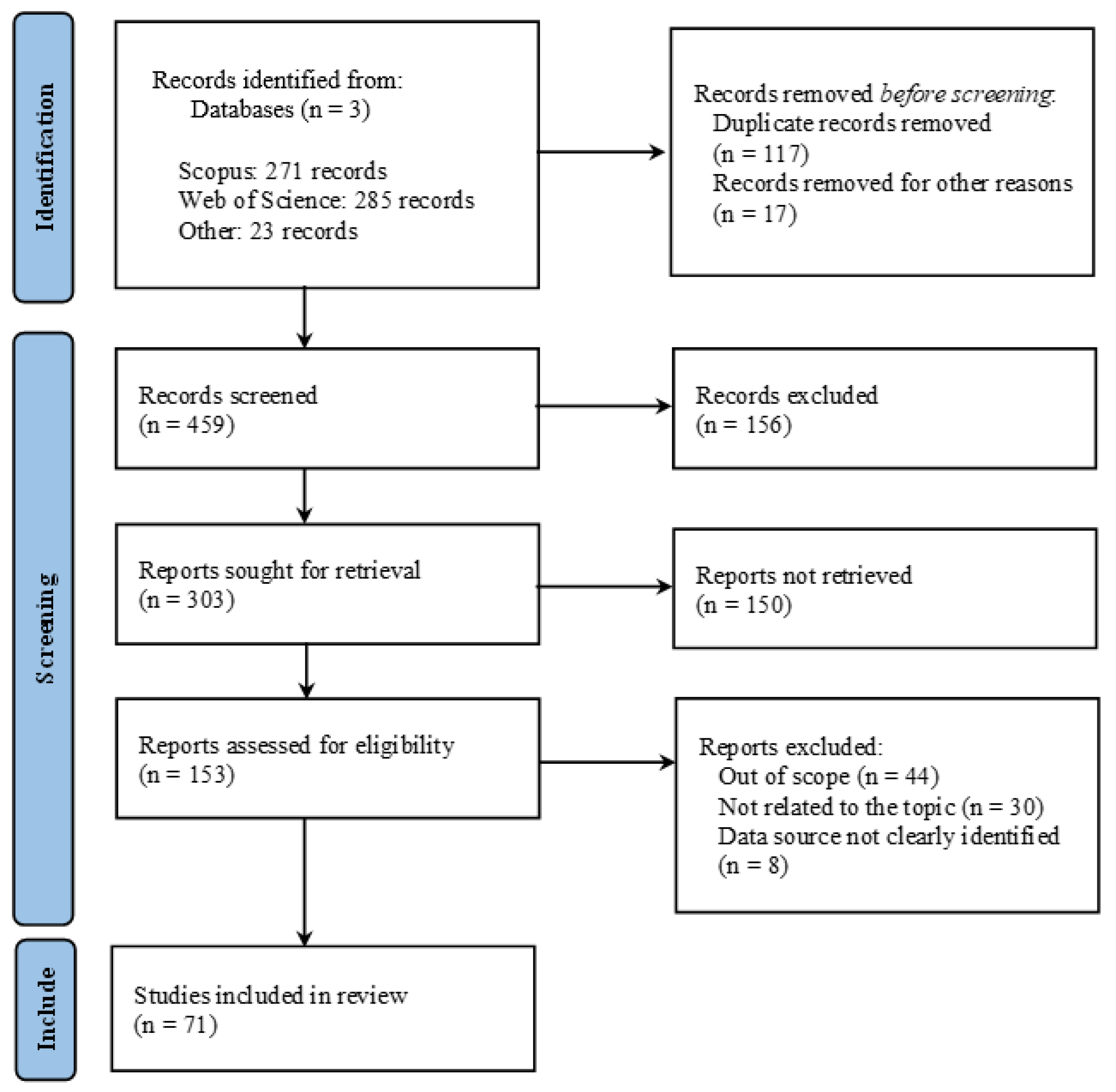
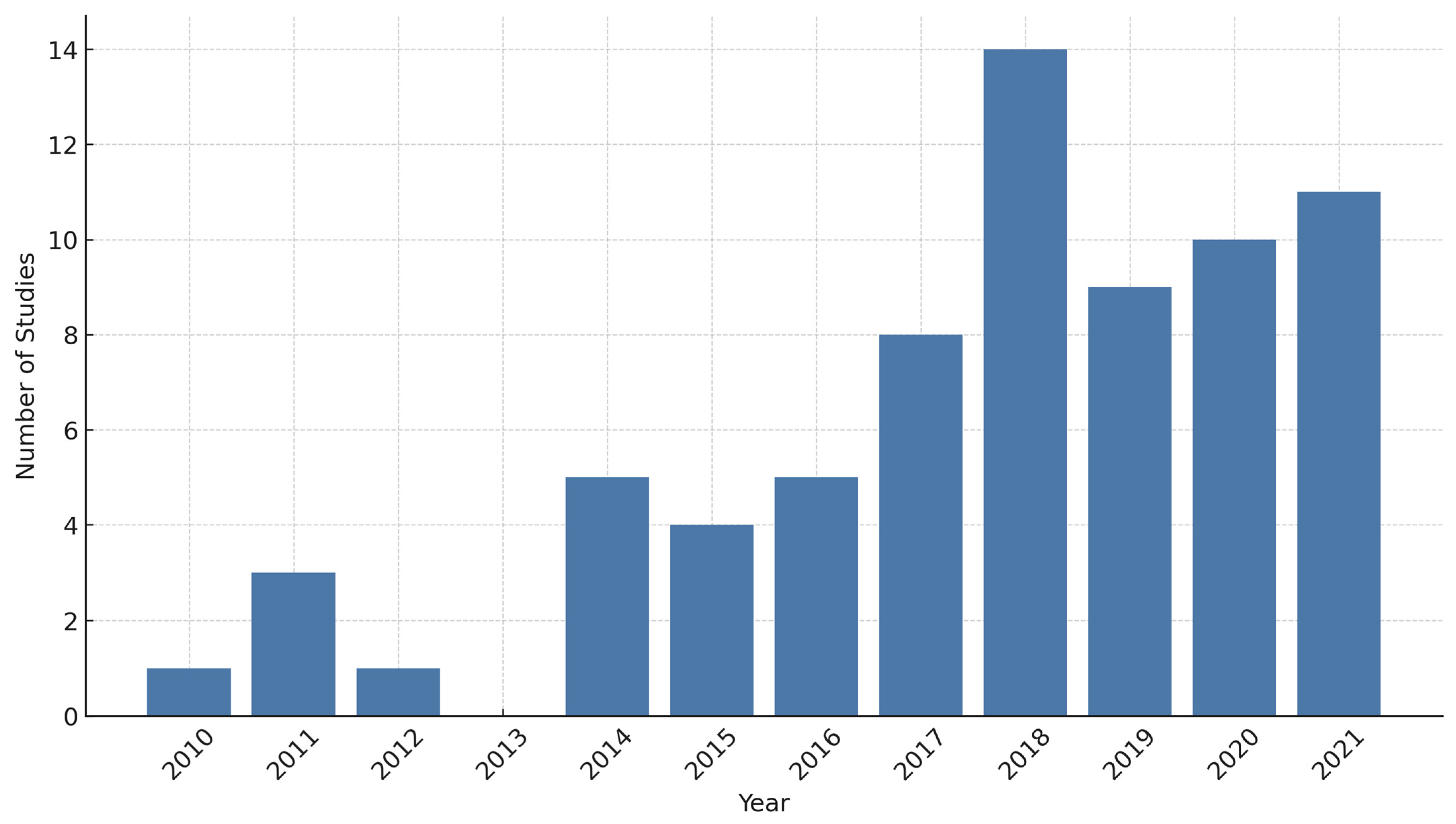
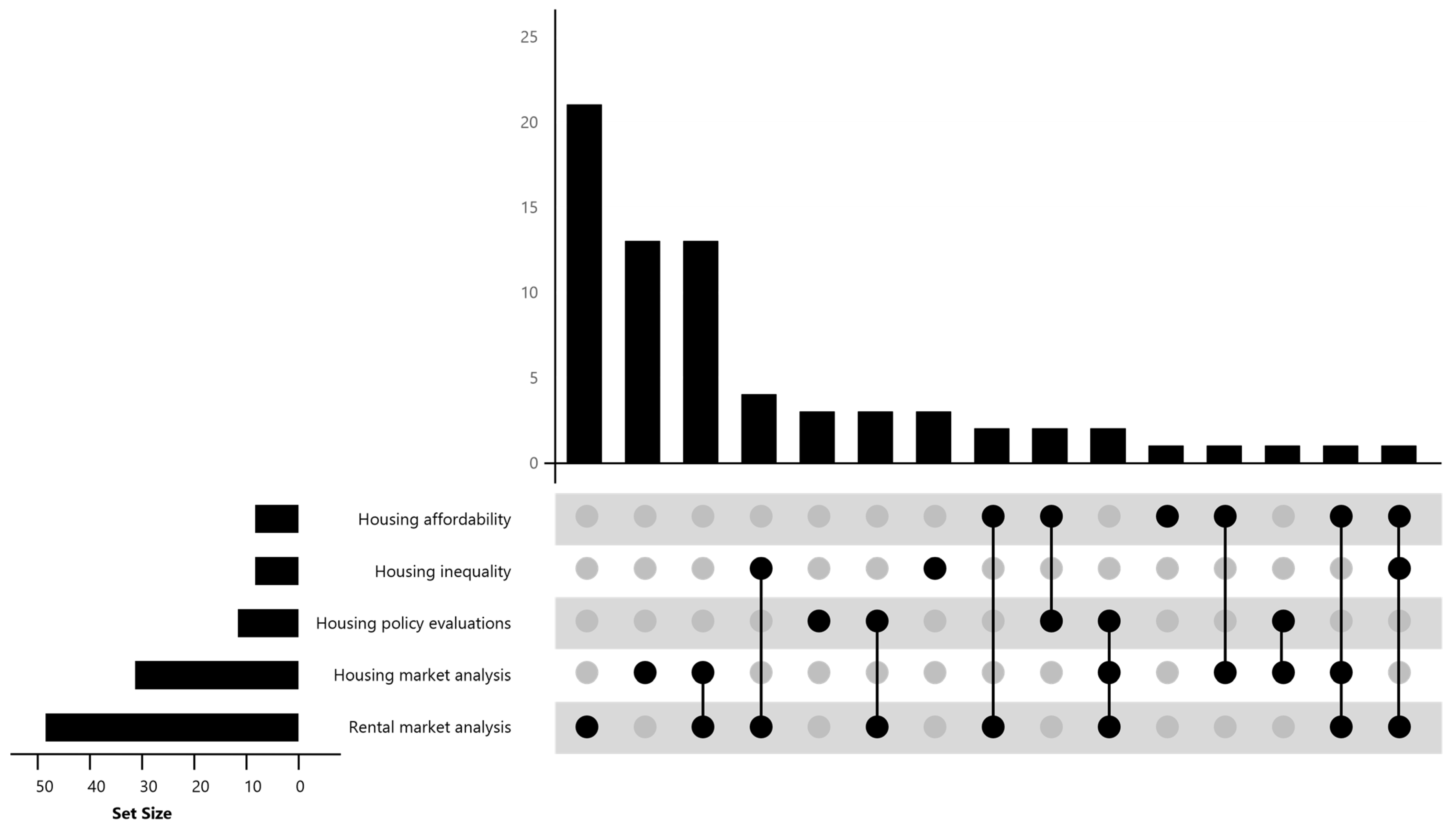
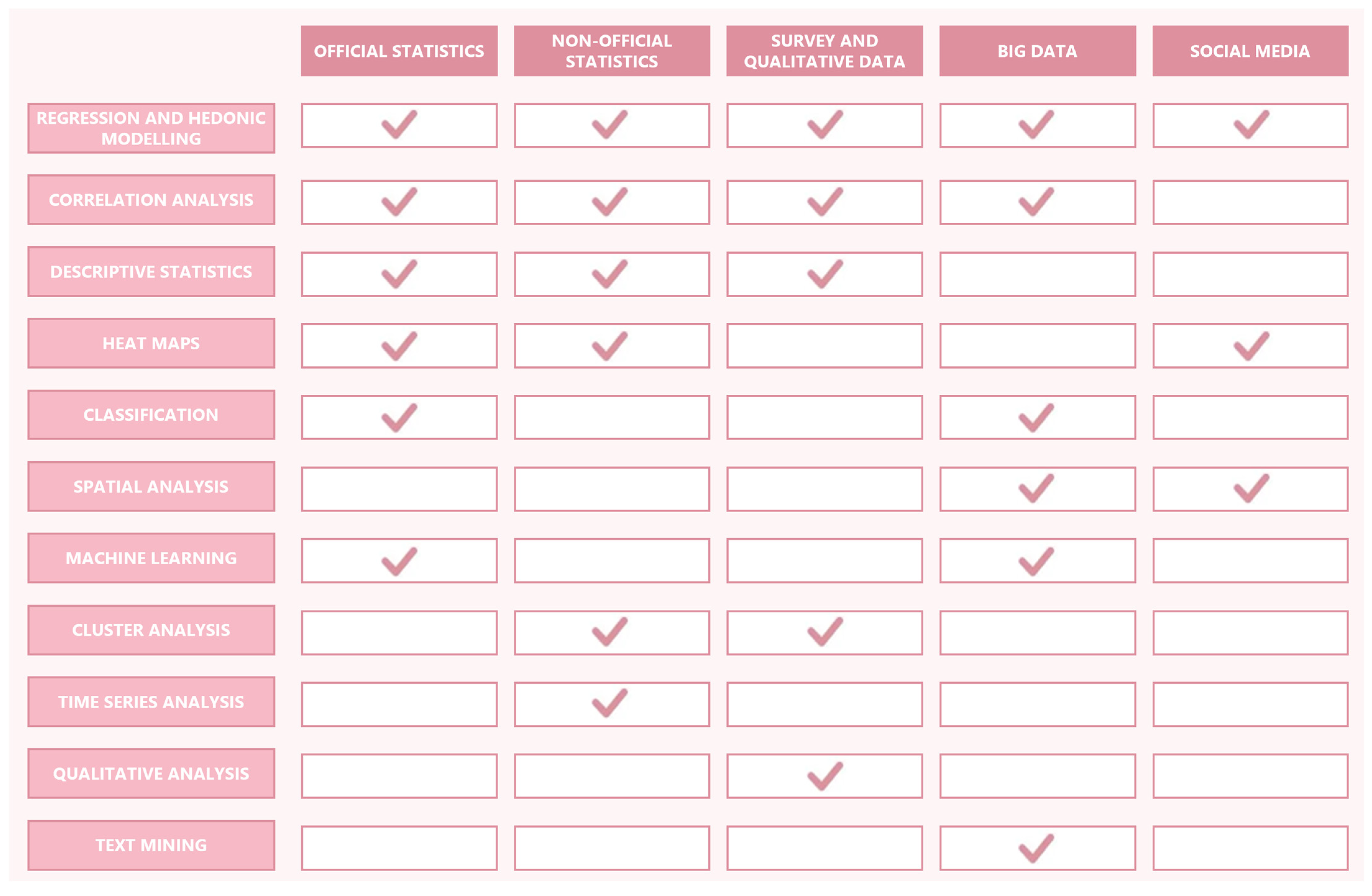
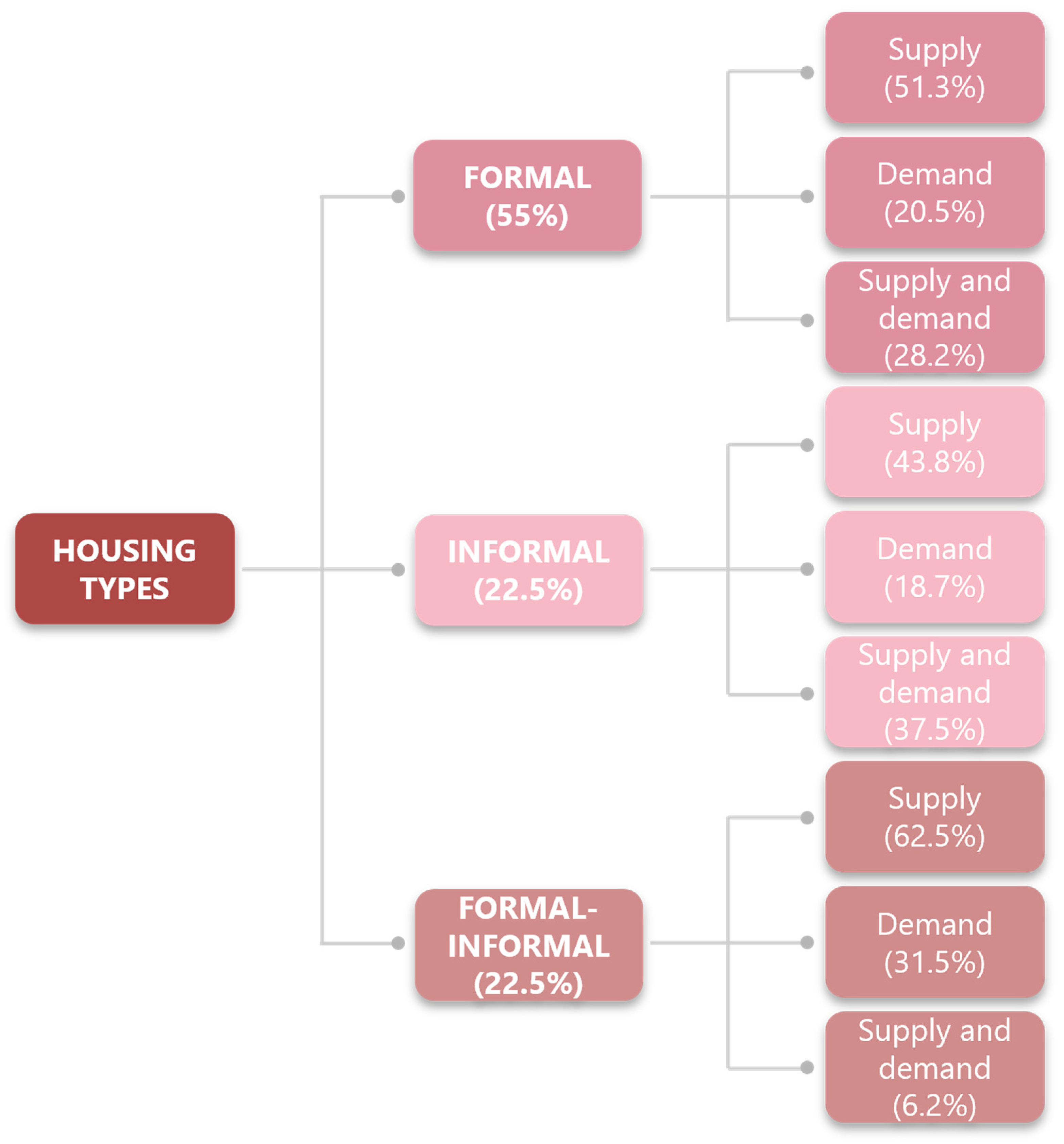
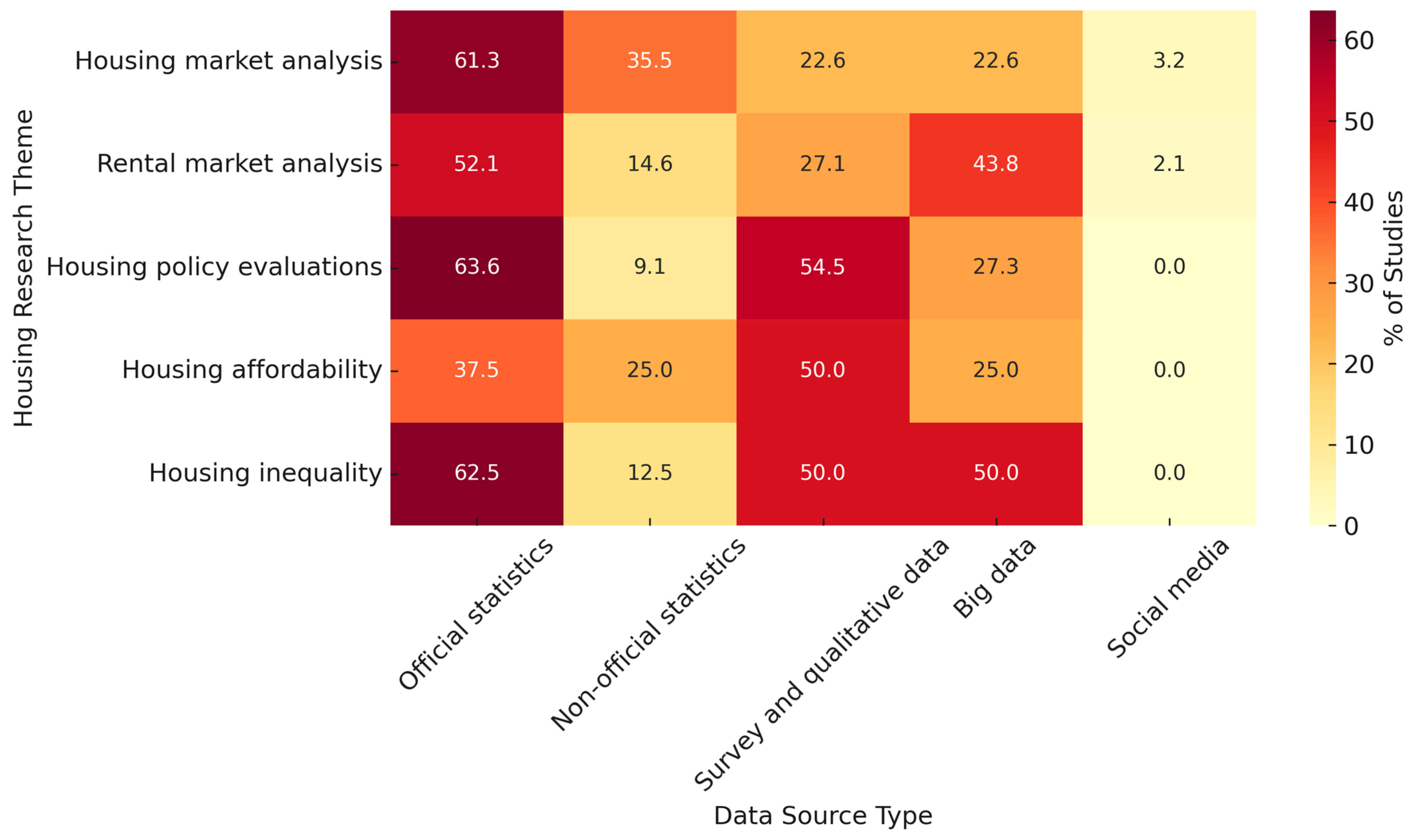
| Study | Focus Area | Typology Basis and Types | Geographic Scope | Limitation |
|---|---|---|---|---|
| Fields and Rogers [4] | Real estate platforms | Functionality of platform: trading platform, operational platform, data platform | US, Canada, China, Australia | Excludes social media; focused on formal data |
| Goodchild and Ferrari [15] | Digital housing platforms | Platform roles: connectors, enablers, matchmakers, hubs | UK | Excludes social media; focused only on formal markets |
| Serin [18] | Housing supply | Policy: planning, regeneration and development, design construction and quality, tenure, new builds, private residential developers, affordable and social housing, energy consumption | UK | Regulations oriented; focused only on supply |
| Naik [19] | Informal rental housing | Physical and service: semi-permanent residence, permanent multi-story residence, rooms with shared toilets, rooms with separate toilets | India | Qualitative only; limited to informal rental |
| Khaire and Muniappa [21] | Housing policy research | Four themes: policy, slum housing, housing finance, affordable housing | India | Focused on policy themes; no analytical framework across data types |
| Maalsen [20] | Shared housing | Legal and social status of tenants: co-tenant, head-tenant, formal sub-tenant, informal sub-tenant, boarder or lodger | Australia | Narrow scope; specific to rental law categories |
| Theme | Cross-Theme | Objectives | Citation |
|---|---|---|---|
| Housing market analysis | - | Housing price analysis | [23,24,25,26,27,28] |
| Analysis of demand against supply | [12,29,30] | ||
| Factors influencing housing demand and supply | [31,32] | ||
| Determinants of supply and construction of housing units | [33,34] | ||
| Rental market analysis | Factors influencing housing demand | [13,35,36,37,38,39] | |
| Housing price analysis | [40,41,42,43,44,45,46] | ||
| Rental market—policy evaluation | Housing demand estimation | [47] | |
| Housing poverty assessment | [48] | ||
| Rental market—affordability | Housing demand analysis | [49] | |
| Policy evaluation | Impact of short-term rentals on housing market | [50] | |
| Affordability | Housing price analysis | [51]. | |
| Rental market analysis | - | Factors influencing rental housing demand | [6,52,53,54,55] |
| Rental price analysis | [5,56,57,58,59,60,61,62,63,64] | ||
| Mapping and prediction of rental prices and supply | [65,66,67,68] | ||
| Reliability of rental data available on online platforms | [69] | ||
| A review of shared housing | [70] | ||
| Housing policy evaluation | Density control in metropolitan areas | [71] | |
| Examination of informality on housing market | [8] | ||
| Impact of policy regulations on informal housing | [10] | ||
| Affordability | Impact of housing supply on affordability | [72] | |
| Impact of informal housing on housing supply | [73] | ||
| Inequality | Analysis of the slum challenges for developing countries | [74] | |
| Evaluation of discrimination in rental markets | [75] | ||
| Information inequality and bias in housing supply | [76,77] | ||
| Affordability–inequality | Impact of informal housing on affordability | [78] | |
| Policy evaluation | - | Impacts of policy and regulatory changes on housing | [79,80,81] |
| Affordability | Analysis of the housing choice factors | [82] | |
| Impact of changes in rental markets on affordability | [83] | ||
| Affordability | - | Review of the challenges faced by low-income groups | [84] |
| Inequality | - | Inequality investigations in housing markets | [85,86,87] |
| Data Source Typology | Supplementary Data Source | Examples of Data Sources | Reviewed Studies |
|---|---|---|---|
| Official statistics | - | American Community Survey; population censuses; National Property and Information Centre (NAPIC) | [23,24,33,34,39,40,47,54,59,72] |
| Non-official statistics | eCognition; Chartered Institute for Public Finance and Accountancy; Central Bank of Turkey; Thomson Reuters DataStream; https://www.airdna.co/ (accessed on 14 April 2025) | [25,26,27,29,31,46,49,81] | |
| Surveys and qualitative data | Interviews; questionnaire surveys | [48,75,79,86] | |
| Big data | CoStar Group for rental data; Craigslist; Apartments.com (accessed on 14 April 2025); daft.ie (accessed on 14 April 2025) | [5,43,45,50,56,63,64,67,70,71,77,80,87] | |
| Non-official statistics | - | dhiperiti.com; EUROSTAT; Data provided by real estate agencies | [32,41,51,62,85] |
| Big data | www.creprice.cn (accessed on 14 April 2025) | [42] | |
| Surveys and Qualitative data | Household surveys; structured and unstructured questionnaires; structured interviews and focus groups | [8,10,12,13,35,36,37,38,53,55,57,58,74,82,83,84] | |
| Big data | 58.com (accessed on 14 April 2025); geofabrik.de (accessed on 14 April 2025) | [68,69] | |
| Big data | - | Craigslist; Ganji; Anjuke; 58tongcheng; bjhouse.com (accessed on 21 February 2021) | [28,30,44,60,65,76] |
| Social media data | Sina; SOFANG; Fangtianxia | [6,28] | |
| combination of data sources | CREIS Databank; China Meteorological Data Service Centre; official statistical yearbooks; National Bureau of Statistics of China; Australian Bureau of Statistics (ABS); Flatmates.com.au (accessed on 14 April 2025); Rent and Sales Report, NSW government | [42,78] | |
| Social media | Big data | Sina; Lianjia | [6,28] |
| Data Analysis Methods | Data Sources | Reviewed Studies |
|---|---|---|
| Correlation analysis | Official statistics | [5,23,26,33,42,46,47,48,52,54,61,63,71,77,79,81] |
| Non-official statistics | [26,42,46,61,81,85] | |
| Big data | [5,42,63,69,71,77] | |
| Surveys and qualitative data | [13,48,52,53,69,74,82,86] | |
| Regression modelling | Official statistics | [25,26,34,39,40,42,45,47,54,63,71,77,87] |
| Non-official statistics | [25,26,32,41,42,62,85] | |
| Big data | [42,44,45,63,68,71,77,87] | |
| Surveys and qualitative data | [12,37,38,57] | |
| Social media | [28] | |
| Hedonic modelling | Official statistics | [24,27,29,43,45,49,50,67,75] |
| Non-official statistics | [27,29,49,62] | |
| Big data | [28,30,35,43,44,45,50,56,60,67,69,73] | |
| Surveys and qualitative data | [36,53,57,69,75] | |
| Social media | [28] | |
| Descriptive statistics | Official statistics | [23,25,31,35,47,51,55,61,63,64,71] |
| Non-official statistics | [25,31,41,61,85] | |
| Big data | [60,63,64,71,73] | |
| Surveys and qualitative data | [38,53,55,57,58,74,82,83,84] |
| Housing Types | Supply and Demand Perspectives | Data Source Type | |||||
|---|---|---|---|---|---|---|---|
| Perspective | Percent | Official Statistics | Non-Official Statistics | Survey and Qualitative Data | Big Data | Social Media | |
| Formal (n = 39; 55%) | Supply | 51.3% | 70.0% | 35.0% | 15.0% | 30.0% | - |
| Demand | 20.5% | 37.5% | 12.5% | 50.0% | 12.5% | - | |
| Supply and demand | 28.2% | 54.5% | 72.7% | 9.0% | 18.2% | - | |
| Informal (n = 16; 22.5%) | Supply | 43.8% | 71.4% | 28.5% | 57.2% | 71.4% | - |
| Demand | 18.7% | - | - | 66.7% | 33.3% | 33.3% | |
| Supply and demand | 37.5% | 16.7% | - | 83.4% | 33.3% | - | |
| Formal-informal (n = 16; 22.5%) | Supply | 62.5% | 60.0% | 20.0% | 20.0% | 90.0% | - |
| Demand | 31.5% | 20.0% | - | 60.0% | 20.0% | 20.0% | |
| Supply and demand | 6.2% | - | - | 100.0% | - | - | |
Disclaimer/Publisher’s Note: The statements, opinions and data contained in all publications are solely those of the individual author(s) and contributor(s) and not of MDPI and/or the editor(s). MDPI and/or the editor(s) disclaim responsibility for any injury to people or property resulting from any ideas, methods, instructions or products referred to in the content. |
© 2025 by the authors. Licensee MDPI, Basel, Switzerland. This article is an open access article distributed under the terms and conditions of the Creative Commons Attribution (CC BY) license (https://creativecommons.org/licenses/by/4.0/).
Share and Cite
Kamruzzaman, L.; Nikfalazar, S.; Huda, F.Y.; Arunachalam, D.; Lukose, D. Data Typologies in Urban Housing Research: A Systematic Review of the Literature. Sustainability 2025, 17, 4809. https://doi.org/10.3390/su17114809
Kamruzzaman L, Nikfalazar S, Huda FY, Arunachalam D, Lukose D. Data Typologies in Urban Housing Research: A Systematic Review of the Literature. Sustainability. 2025; 17(11):4809. https://doi.org/10.3390/su17114809
Chicago/Turabian StyleKamruzzaman, Liton (Md), Sanaz Nikfalazar, Fuad Yasin Huda, Dharmalingam Arunachalam, and Dickson Lukose. 2025. "Data Typologies in Urban Housing Research: A Systematic Review of the Literature" Sustainability 17, no. 11: 4809. https://doi.org/10.3390/su17114809
APA StyleKamruzzaman, L., Nikfalazar, S., Huda, F. Y., Arunachalam, D., & Lukose, D. (2025). Data Typologies in Urban Housing Research: A Systematic Review of the Literature. Sustainability, 17(11), 4809. https://doi.org/10.3390/su17114809






